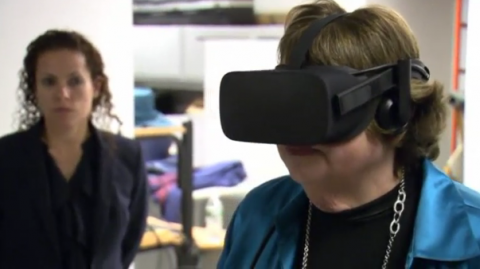
NEW YORK, United States (Reuters) — New York University researchers have developed a system combining virtual reality with a pressure sensing mat they say could help people with vestibular dysfunction, which affects parts of the inner ear and brain and results in problems with balance and those suffering from vertigo or dizziness as a result of a brain injury.
Mary-Lynn Musco got into a near-fatal car crash more than a decade ago and receives physical therapy for her knee replacements. She was recommended for virtual reality balance therapy and has so far had seven sessions with Dr. Anat Lubetzky, assistant professor in the physical therapy department at New York University, who heads the research project.
For these therapy sessions, Musco steps on a pressure sensing mat, dons a virtual reality headset and ducks while spheres are being virtually thrown at her, or looks up and down while maintaining balance in a virtual city landscape.
“This is meant to sort of throw you off,” Musco said. “Balls are coming at you. Hopefully that doesn’t happen on 8th Avenue. But it does translate into people coming at you, cars, bicycles, trucks. So it’s a little bit the same thing, although here it’s kind of measured and you know that in another minute the ball’s going to be coming toward your head and how you’re going to react to it. And sometimes it catches you off guard like it does in real life and sometimes you’re prepared for it. It’s a little, you know, it’s strange for me because I never wore these glasses until I came here. So I never had any sort of experience with virtual reality that a lot of kids play games with. So it was a little disconcerting at first because you think that there’s a right way or wrong way to react instead of just reacting.”
The biggest thing Musco has noticed about her balance since beginning her sessions with Lubetzky is a sense of confidence.
“You notice things like, I’m at my desk at work, you know as people are, and I would stand up and want to go down the hall to get something,” Musco said. “Well I’d stand up and want to make sure I wasn’t off balance. Now I just stand up and walk. I don’t even think about it. I know when I used to cane for almost a year and I I said to my orthopedic surgeon, ‘When can I get rid of this cane?’ And he says, ‘When you get up and forget where it is.’ So it’s sort of the same thing. You don’t even think that, oh boy my balance is better. I think I’m just walking.”
For her project, Lubetzky uses virtual reality environments in conjunction with a pressure sensing mat and a head tracking software in order to assess and treat problems with balance that are related to sensory issues.
Lubetzky was initially using her system to assess and measure 27 patients with balance issues and collect that data. What she found, through Musco and other patients, was that their balance was improving in the real world with each virtual reality session. However, the research is still in its early stages and varies with each patient.
“What we know about balance today is that there is no one size fits all type of intervention for balance problems,” she said. “If you identify the underlying cause of the balance problem and you intervene at that level, hopefully you will have better outcomes.”
Ken Perlin, a computer science professor at New York University and co-founder of Tactonic Technologies, the team that invented the pressure-sensing mat, likened the mat to Harry Potter’s Marauder’s Map.
“It’s a flat floor mat that acts like a video camera for pressure,” he said. “When you stand on it you can see wiggling of your toes, leaning on your heel, footsteps.”
According to the Centers for Disease Control and Prevention, healthcare costs related to falls for Medicare in 2015 were over $31 billion (USD).
“With Anat’s insight about how to combine visual feedback with touch feedback on your feet, we’re able to provide a very powerful instrument not only for figuring out which of those five systems has failed but also being able to provide at low cost, a training intervention,” Perlin said. “So that, I see you need to beef up your ability to use your inner ear, you need to work with your impaired eyesight, you need to work with using the bottoms of your feet. Each person is different and unless you have a good diagnostic tool doesn’t matter what else you do. But we can provide the diagnostic tool and the training and that’s going to be pretty powerful in helping to save lives.”
The pressure mats are currently $800 but Perlin says that once they’re able to make the mats in large volume by the end of the year, they can go down to $50 a square foot.







